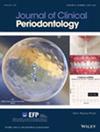Microbiological, Inflammatory and Clinical Outcome of Citric Acid Passivated Definitive Abutments: Interim 12-Month Results From a Randomised Controlled Clinical Trial
Abstract
Aim
To assess the efficacy of citric acid passivation on implant abutments by evaluating their impact on bacterial load, microbiome composition, inflammatory response, and clinical and radiographic outcomes compared with control abutments over a 12-month follow-up period.
Methods
Implants were placed subcrestally in the posterior sextants and randomly assigned to receive a 2-mm high definitive abutment, either with citric acid passivation (CA group) or without (CTR group). Final restorations were delivered after 12 weeks. Samples of the peri-implant crevicular fluid were collected at 3, 6 and 12 months for microbiological and inflammatory analysis. Clinical and radiographic measurements were also performed at these intervals. The primary outcome was total bacterial quantification (log CFU/mL).
Results
Data from 17 patients in the CA group and 16 in the CTR group were analysed. At 12 months, there were no significant differences in total bacterial load between groups (p = 0.689). The biofilm was predominantly composed of commensal bacterial genera in both groups throughout the study period. Although no significant differences were observed in the microbiome alpha- and beta-diversity (p > 0.05), the microbiome within study time points showed an increased beta-diversity in the CA group at 12 months (p = 0.019). CA abutments also showed a higher differential abundance of peri-implant pathogenic bacterial genera at 12 months. At the 6-month mark, the CA group exhibited a trend toward lower IL-1β levels compared with the CTR group (p = 0.072). No significant differences were noted in other clinical or radiographic parameters.
Conclusions
Citric acid passivation of definitive abutments does not enhance the microbiological or inflammatory profiles in the short term. Further studies are needed to explore the potential benefits of citric acid passivation on implant abutments.
Trial Registration: Initially registered on clinicatrials.gov (NCT05592327)

 求助内容:
求助内容: 应助结果提醒方式:
应助结果提醒方式:


